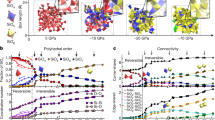Abstract
THE behaviour of α-quartz, one of the most common tetrahedrally coordinated silica polymorphs, at high pressures has been the subject of several experimental studies. At room temperature, gradual pressure-induced amorphization is observed (at about 25-35 GPa)1,2, followed at higher pressures (above 60 GPa) by a transformation to a crystalline octahedrally coordinated 'rutile-like' structure3. The driving force for these transformations is not well understood. We report here first-principles calculations of the electronic and structural properties of the high-pressure structure of α-quartz, which show a pressure-induced transformation of the oxygen sublattice to a body-centred cubic structure. The main features of cubic packing are present at 30 GPa, and the ideal form is achieved at about 60 GPa. The formation of the cubic sublattice facilitates structural transformations involving a change in Si coordination. In the oxygen body-centred cubic lattice, a small displacement of Si ions along the empty channels of the structure is sufficient to transform α-quartz either to a structure with mixed fourfold/sixfold coordination or, for a larger silicon displacement, to a purely sixfold-coordinated structure. This description is consistent with the evidence of intermediate crystalline phases with mixed Si coordination above the amorphization pressure in molecular-dynamics simulations4, and can also explain the transformation to a sixfold crystalline structure at higher pressure.
Similar content being viewed by others
References
Hemley, R. J., Jepcoat, A. P., Mao, H. K., Ming, L. C. & Manghnani, M. H. Nature 334, 52–54 (1988).
Hazen, R. M., Finger, L. W., Hemley, R. J. & Mao, H. K. Solid State Commun. 72, 507–511 (1989).
Tsuchida, Y. & Yagi, T. Nature 347, 267–269 (1990).
Tsuneyuki, S., Matsui, Y., Aoki, H. & Tsukada, M. Nature 339, 209–211 (1989).
Hazen, R. M. & Finger, L. W. Comparative Crystal Chemistry (Wiiey, New York, 1982).
Sowa, H. Z. Kristallogr. 184, 257–268 (1988).
Chelikowsky, J. R., King, H. J. Jr, Troullier, N., Martins, J. L. & Glinnemann, J. Phys. Rev. Lett. 65, 3309–3312 (1990).
Chelikowsky, J. R., Troullier, N., Martins, J. L. & King, H. Jr Phys. Rev. B (in the press).
Geisinger, K. L., Gibbs, G. V. & Navrotsky, A. Phys. Chem. Minerals 11, 266–283 (1985).
Author information
Authors and Affiliations
Rights and permissions
About this article
Cite this article
Binggeli, N., Chelikowsky, J. Structural transformation of quartz at high pressures. Nature 353, 344–346 (1991). https://doi.org/10.1038/353344a0
Received:
Accepted:
Issue Date:
DOI: https://doi.org/10.1038/353344a0
- Springer Nature Limited
This article is cited by
-
Universal elastic-hardening-driven mechanical instability in α-quartz and quartz homeotypes under pressure
Scientific Reports (2015)
-
Transformation pathways of silica under high pressure
Nature Materials (2006)
-
The flexibility window in zeolites
Nature Materials (2006)





